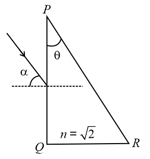MEDIUM
Earn 100
The angle of deviation depends on the refractive index of the glass.
(a)True
(b)False
87.5% studentsanswered this correctly
Important Questions on Light
EASY
HARD
EASY
EASY
MEDIUM
EASY
MEDIUM
MEDIUM
MEDIUM
EASY
MEDIUM
EASY

EASY
EASY
EASY
MEDIUM
EASY
EASY
EASY

